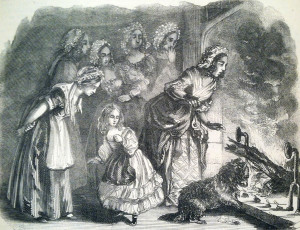As we approach the last week of April, we come to St. Mark’s Day on the 25th, and, as with most holidays, its more important eve the night before. This practice comes to us from the traditional reckoning of time and the practice of experiencing days from sunset to sunset… which, when you think about it, is somewhat more practical than the random Stroke of Midnight beginning we follow nowadays. More practical and more natural, attuned to the natural rhythms of day and night.
And so with the setting sun on the 24th we have St. Mark’s Eve, set aside as one of the traditional nights for divining the future. This is especially true for matters of the heart. One of the most common divination spells is as follows: Fast from sunset on St. Mark’s Eve and during the night, bake a cake that contains an eggshellfull of salt, wheat meal, and barley meal. Set the baked cake to cool on the table and leave the door to your home open. Sometime over the course of the night your future love will come in and turn the cake.
Certainly a spell like this harkens back to simpler times, when we were less in need of locking our doors at night, let alone leaving them open. Personally, I’d go with the security of a locked door and just wait to meet my future love in a more public place.
Others use the Eve of St. Mark to foresee the shadows of all in the village who would be buried in the churchyard in the coming year. Great fun, of course! This requires some planning ahead, however, as the spell needs three years to work. For each of three St. Mark’s Eves in a row you’ll need to fast and then spend the hours between 11 PM and 1 AM sitting on the porch of a church. Come the third year, in that witching hour, you should see a procession pass before you of the shadows of all who will die in the coming year, as this excerpt from a poem by James Montgomery suggests:
‘Tis now, replied the village belle,
St. Mark’s mysterious eve,
And all that old traditions tell
I tremblingly believe;
How, when the midnight signal tolls,
Along the churchyard green,
A mournful train of sentenced souls
In winding-sheets are seen.
The ghosts of all whom death shall doom
Within the coming year,
In pale procession walk the gloom,
Amid the silence drear.
The poem is titled “The Vigil of St. Mark.” But back to matters of the heart: Just as at Halloween, there is as well a long standing tradition of divination by nuts on St. Mark’s Eve. Young women would set a row of nuts on the hot embers of the hearth, one for each girl. Each would breathe the name of her intended into the hearth and if the love was to be true, the nut would jump away as it got hotter. But if the nut sat there and was consumed by the fire, the love was not meant to be:
If you love me, pop and fly,
If not, lie there silently.
The morning brings St. Mark’s Day, with blessings upon the newly sown crops. Summer will soon be returning (in fact, it’s right around the corner, again by traditional reckoning of time: May Day is drawing near). With summer comes the arrival of migratory birds to northern climes, and birds are an important part of the festivity of St. Mark’s Day: Cuckoos, in particular, and in England, the cuckoo is also known as St. Mark’s Gowk. The blessings upon the crops go back to a much earlier celebration of late April: the Ancient Roman festival of Robigalia, celebrated to appease the mildew spirit and to keep those newly sown crops healthy and thriving.
Image: An engraving of divination by nuts taken from the Chambers Bros. Book of Days, Edinburgh, 1869.

[…] The Mystery of St. Mark’s Eve […]